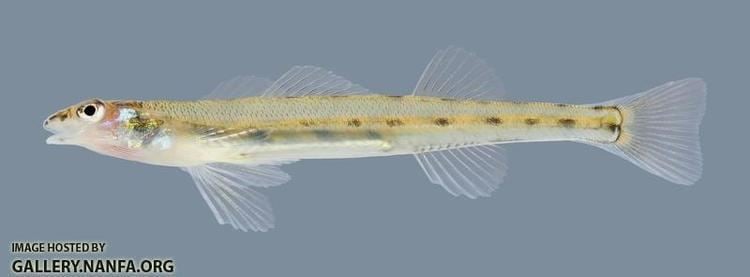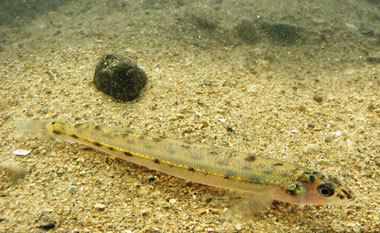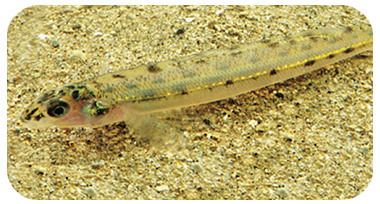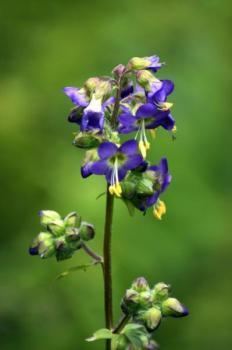Phylum Chordata Rank Species | Scientific name Ammocrypta pellucida Higher classification Ammocrypta | |
 | ||
Similar Ammocrypta, Channel darter, Northern madtom, Pugnose shiner, Greenside darter | ||
Eastern sand darter
The eastern sand darter (Ammocrypta pellucida) is a fish species of the Percidae family. The eastern sand darter is a relatively small perch, most plentiful in the Mississippi and Ohio Rivers, as well as Lakes Champlain, Erie, Huron, Michigan, and Ontario. It prefers sandy-bottomed streams and sandy shoals in the lakes. The eastern sand darter feeds on larvae of black flies and other small insects in the water. They also feed on zooplankton in small portions due to their small mouth size limiting their gape ability. Their average body size is around 1.5-2 in long and it breeds in the spring and summer in sandy-bottomed waters.
Contents

Distribution

The eastern sand darter can be found in many areas throughout the United States and into southern Canada. In addition to the Mississippi and Ohio Rivers, it can be found in great concentration in Lake Champlain, Erie, Huron, Michigan and Ontario. They can also be found in the St. Lawrence River drainage in Canada along with the Lake Champlain drainage in Vermont south into New York, Pennsylvania, West Virginia, Kentucky, Illinois, and Indiana. Currently, the greatest concentration occurs in northern Alabama and eastern Tennessee. Distribution has slowly decreased over the last few decades and two key factors could be the cause. The eastern sand darter requires clean sand substrates; hence, siltation is a major factor in their decline. Siltation decreases the quality of habitat for both egg development and adult darters by decreasing the oxygen levels within the sand in which they bury themselves. Furthermore, silted habitats can cause adult darters to not fully burrow or decrease their time burrowed which then causes them to waste energy reserves. Channel or water flow alterations, nutrient enrichment, or any other habitat modification can completely change the amount and quality of the shifting sand bars which can then turn detrimental for the eastern sand darter. The increased construction of dams also has been a major factor contributing to the reduction of their habitats. Dams reduce river levels and flow, decrease oxygen levels in reservoir waters, and alter water temperatures, making it difficult for the eastern sand darter to reproduce at a comfortable temperature. Dam construction adds a whole new dimension to decreasing the reproduction and survival rate for A. pellucida.
Ecology

This fish seeks its prey from the sand along the bottom of the stream or lake. “Their prey items usually range in size up to 3/16 inches, but prey selection varies depending on the age of the darter. Juvenile eastern sand darters consume small crustaceans, while adults prefer midge larvae, blackfly larvae, mayflies, and caddisflies.” It has several species of fish predators, including rainbow trout, largemouth and smallmouth bass, and rock bass. However, due to extensive time spent buried in the sand and its translucent body, the eastern sand darter usually tends to be protected from predators. Minnows are the eastern sand darters' biggest competitor for food, but little conflict arises between the two due to the darter occupying the lowest depths of the rivers and lakes while the minnows occupy the upper water column.
Life history

The average lifespan for the eastern sand darter is about 2–3 years, but if the siltation and pollution continue to worsen, the lifespan will gradually decrease. A. pellucida reproduces in the sandy shoals at the bottom of the lakes and rivers it inhabits during the spring and summer when the water is at its warmest temperature. It reaches sexual maturity around age one and the males are able to mate once during the breeding season, while females mate twice, producing about 350 eggs with an average clutch size of 71 eggs. If siltation continues to worsen, many of the eggs will be smothered, resulting in reduced reproduction, further hindering the eastern sand darters' population count.

